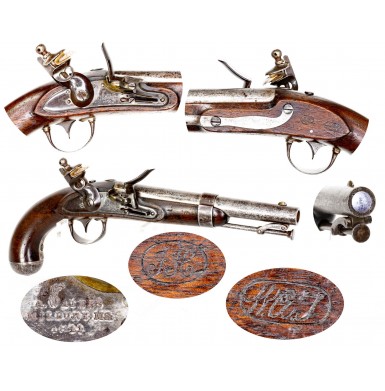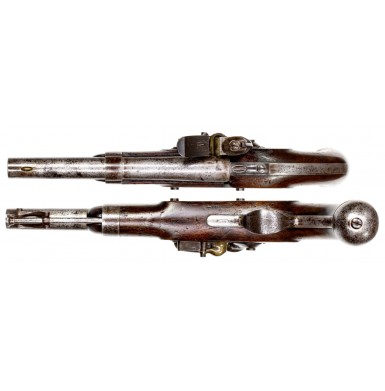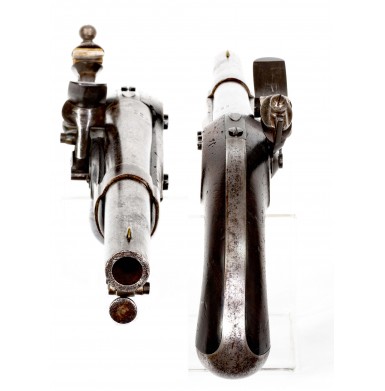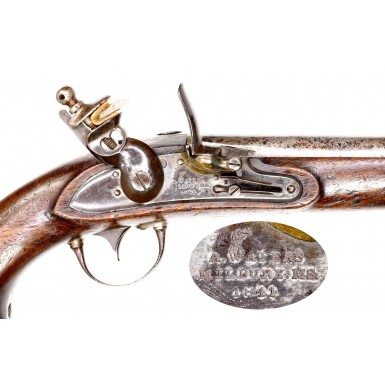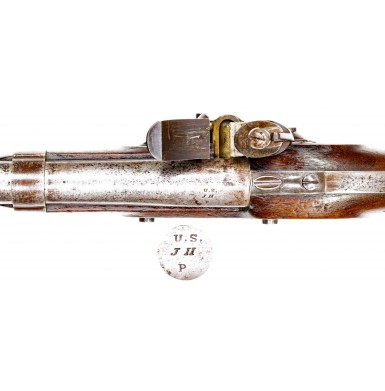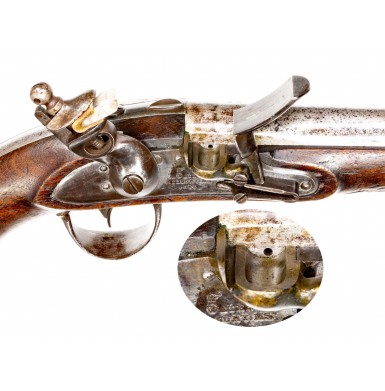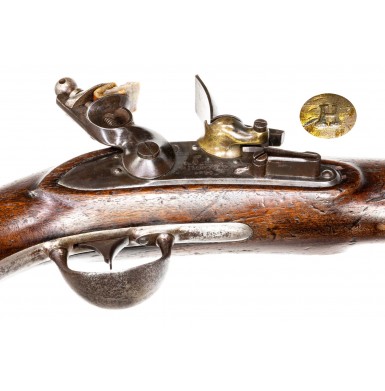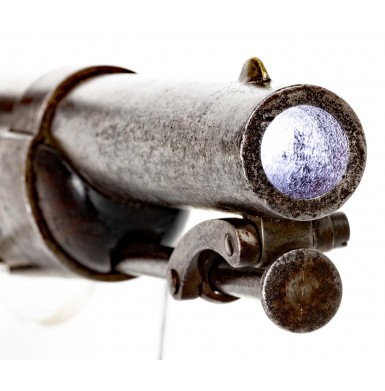Attractive & Nicely Priced US Model 1836 Pistol by Waters in Original Flint
- Product Code: FHG-2300-SOLD
- Availability: Out Of Stock
-
$1.00
The US Model 1836 Pistol was a unique handgun in the history of US martial arms. It was the last of the single-shot martial flintlock pistols to be authorized and contracted for by the US government, and it was the first contract small arm that appears to have been designed by the contractor, and not based upon a US armory produced sample firearm. At the very least, no “USM” – “US Model” marked examples are known and no period documentation reveals the manufacture of such model pistols at either national armory, even as preproduction samples. A total of 41,000 of the pistols were contracted for between 1836 and 1844. Robert Johnson of Middleton, CT designed the pistol and produced a total of 18,000 of the guns (about 44%). Asa Waters (and later A.H. Waters) of Millbury, MA produced the balance of 23,000 of the pistols.
The contract was entered into at a very tumultuous time in US military history. The Second Seminole War had erupted in December of 1835 and both the newly authorized 2nd US Dragoons and the many mounted state militia troops that were sent to swamps of Florida to deal with the situation were in need of pistols. The stores of pistols in US arsenals were rather small at this point of time. Most of the pistols in storage were the obsolete and rather bulky US Model 1816 pattern, which was not considered to up to the current standards for military use. The lack of pistols was further exacerbated by the very limited production of contract handguns over the previous decade. As a result of the need to arm the US Dragoons, state militia troops being called up for the war and to catch up on backordered requisitions for pistols from the states under the Militia Act of 1808, extreme pressure was applied to both the contractors to deliver the guns and the US ordnance inspectors to approve them for service. This created a pressure point in the facilities of the contractors where assembled pistols sometimes languished while waiting for an Ordnance Department inspector and accepting officer to view the pistols. New standards for small arms inspection had been published in the Ordnance Regulations of 1834 and specified that two inspectors should view and mark all contract ordnance. The Armory sub-inspector (a civilian employee of one of the US arsenals, typically Springfield) would inspect each part in detail, stamping his initials on proved barrels prior to their assembly into complete arms, and inspecting the various parts of the arms, both large and small. The sub-inspector would also inspect the finished product, disassembling the arms as necessary and affixing his initial to the major components of the gun; the old saying “lock, stock & barrel” originates here, referring to the inspection process. The inspector would mark all of the completed arms on the underside of the flash pan, the stock flat opposite the lock, and the left breech flat with his initial. He would further mark the stock with his cartouche, verifying that the gun had been completely inspected. The Ordnance Department accepting officer would then double check the inspection, although not in such detail, and would stamp his acceptance cartouche on the stock flat (normally towards the rear), indicating the gun had been accepted for US service and verifying that it could be paid for. The Ordnance Officer who was appointed as the “Superintendent of Inspection” was expected to personally view (at least casually) and mark all contact small arms and accouterments being delivered to the US government. This was a massive undertaking for any one person, who had to perform the inspections at the contractor’s manufactory, and not at a central depot. The difficulties in making the necessary personal inspection of contract arms during this period have led collectors to note a number of variant US Model 1836 pistols that have only a single inspection cartouche; that of the arsenal sub-inspector, but without the cartouche of the Ordnance Department accepting officer.
The diligent research of American Society of Arms Collector member Lewis F. Southard has allowed collectors to identify the likely disposition of certain examples of Johnson contract US Model 1836 pistols that bear only a single cartouche. By delving into both Johnson factory records and the US Ordnance Department records and correspondence, he has established three occasions where Johnson delivered US M1836 pistols without an accepting officer’s cartouche. During this time, Major Henry Knox Craig of Watertown Arsenal was also the “Superintendent for Inspection” of contact arms and accouterments. Craig was simply swamped by this duty and much of the correspondence unearthed by Southard relates to his requests for help from the head of the US Ordnance Department, Colonel George Bomford. The first two occasions when Craig could not be present to inspect Johnson’s pistols were in 1837. The first was a March 11, 1837 inspection, when sub-inspector Thomas Warner inspected M1836 pistols at Johnson’s facility without Craig there to accept the pistols. The guns are marked with Warner’s script TW cartouche, but do not carry Craig’s HKC mark. Craig was simply spread too thin on contract inspections to be there. The March 11 inspection was for 500 pistols that were subsequently sent to the New York Depot for issue to the 2nd US Dragoons for Seminole War service. These pistols are identifiable by locks dated 1836 or 1837, inspection marks applied by Thomas Warner, and no “HKC” cartouche. The next group of Johnson contract “single cartouche” pistols were inspected by armory sub-inspector Joseph Hannis on October 5, 1837. This group of 500 guns included some with Thomas Warner inspected barrels, left over from an August 1837 inspection of parts by Warner. The balance of the gun is inspected by Hannis, with his small H on the major components and his script JH cartouche on the stock flat. Craig could not be present at the October 5 inspection, as he was inspecting powder flasks at the Ames facility in Cabbotville, MA on that date. These pistols are all 1837 dated, are fully inspected by Hannis and again bear no “HKC” cartouche. It seems likely that most of the 500 pistols from the October 5 inspection were delivered for use by the Tennessee militia, which had been called out for service in Florida. Southard quotes a September 15, 1837 letter to Ordnance Inspector Craig form Colonel Bomford of the Ordnance Department stressing the need to deliver 600 pistols to the Tennessee volunteers that were being sent to Florida to fight the Seminoles. The final group of “single cartouche” pistols was inspected by armory sub-inspector Lewis Foster on August 18, 1838. These 600 guns were delivered to the state of Georgia for Seminole War service as well. They are identifiable by their 1838 lock dates, Foster’s inspection marks throughout, and again the lack of Craig’s inspection mark. Due to the wonderful research conducted by Mr. Southard, we can with some degree of accuracy attribute the destination of these single cartouche US M1836 pistols by Johnson, and we know that they were all bound for Seminole War service. The inspection crisis of 1837 resulted in a Presidential order, signed July 5, 1838 that expanded the officer corps of the Ordnance Department. It authorized the addition of two more majors to facilitate the final inspection and acceptance of the ordnance, as well as the transfer of twenty lieutenants from the artillery branch, ten 2nd lieutenants and ten 1stlieutenants. The two newly appointed majors were formerly captains that had been transferred to service in the Ordnance Department, James Ripley and Mann Page Lomax. By the end of 1838 both of these men were involved fully in the inspection process. While we can see from the above information that some US M1836 pistols that bear no state markings can still be attributed to a likely state by a process of elimination regarding the presence or absence of specific inspection marks, some states did mark their small arms. These include the state of North Carolina. However, most states did not mark the M1836 pistols that they received. As a result, there is no way to determine the disposition of those M1836 pistols with standard dual cartouche inspections and no state marks. Such guns are as likely to have been issued to regular army units as to the various states.
This is an extremely attractive US Model 1836 pistol (Flayderman 6A-030) that is in VERY GOOD+ untouched overall condition. The gun is an 1841 dated example by Water and bears a pair of inspection cartouches on the stock flat. The sub-inspector’s mark is the script JH of Joseph Hannis and the final inspection mark is that of Major of Ordnance William Anderson Thornton, with a script W.A.T. to the rear of the flat. Both cartouches are very crisp and clear, and both are deeply struck. The pistol is in crisp condition and remains in its original flintlock configuration. This is quite uncommon with these pistols, as the majority of these guns ended up being altered to percussion between the mid-1850s and the beginning of the Civil War. The pistol is marked on the lock in four lines forward of the hammer:
{EAGLE HEAD}
A. WATERS
MILBURY, MS
1841
The markings are deeply and clearly struck and remain fully legible. The breech is marked in three lines: U.S. / JH / P. The JH is the mark of armory sub-inspector Joseph Hannis. As noted, the stock flat opposite the lock has a pair of crisp and fully legible scripts cartouches, a JH and a W.A.T.. Hannis’ tiny block letter H mark is also present on the bottom of the brass flash pan, on the left breech flat of the barrel and inside the lock. The presence of Hannis’ sub-inspection on all major components (lock, stock and barrel), indicate that he was the final sub-inspector of the completed pistol, which he subsequently inspected as a finished product with his cartouche. The pistol is in VERY GOOD+ untouched condition overall, with somewhat poorly stored metal and very crisp wood. The metal has a mottled “salt & pepper” patina over most of the barrel with a dull gray pewter gray base color and darker, moderately oxidized gray and blackish discoloration appearing in freckled flecks and patches over much of the barrel. The barrel band and some of the barrel have areas of a smooth, darker brown patina. There is some pinpricking scattered here and there, but other than a couple of patches of pitting on the barrel, it is mostly smooth. There is a thumb-sized patch of pitting on the left side of the barrel near the muzzle and some additional pitting around muzzle and on its face, but otherwise the barrel is mostly smooth. However, the triggerguard is moderately pitted and some lightly scattered pitting is mixed with the mottled oxidized patina on the buttcap and swivel ramrod. There are some traces of the original color casehardened finish on the lock, primarily a small light patch that was protected by the hammer neck. Otherwise the lock has a mostly dark plum patina with some areas of mottling and scattered oxidized discoloration. The lock is mechanically excellent and functions crisply and correctly on all positions. The frizzen remains nice and tight, working as it should, although it shows moderate surface wear on the face. The rounded, fenced brass pan shows good age and shows some moderate verdigris around its edges, as well as old powder residue and stains in the bottom of the pan. As previously mentioned, the bottom of the pan shows the correct sub-inspector mark H. The interior of the lock is completely untouched and unmolested, showing the perfect and precise fit of an original flintlock battery. The touchhole is well centered both vertically and horizontally in the pan. The touchhole shows almost no erosion and remains quite crisp. The iron furniture matches the barrel of the gun perfectly in terms of toning and patination. The .54 caliber smooth bore is in about GOOD condition. The bore is heavily oxidized with scattered light to moderate pitting and a heavy coating of dirt and debris. A serious cleaning and scrubbing would almost certainly improve the condition of the bore. The original swivel rammer is in place under the barrel and it functions perfectly. The stock is in FINE condition and is quite a bit nicer than the metal of the pistol. It is solid and complete with no breaks or repairs. The stock is quite crisp and sharp throughout, without any indications of any sanding or even serious cleaning. The grain remains partly open and the edges are quite crisp and sharp throughout. The stock does show a moderate amount of scattered handling marks, with the expected minor dings, bumps and rubs, as would be expected from a military pistol that is over 175 years old. The stock shows no real damage, only some real world use and has an extremely pleasing look to it overall.
All in all, this is a really strong and solid example of the last official US Martial Single Shot Flintlock pistol. The gun is in its original flint configuration, which is extremely rare for any late model marital flintlock weapon. These pistols were the standard issue handguns during the Second Seminole War and the Mexican War, and nearly all of the surviving pistols saw additional Civil War service of some sort. This is a nice original gun that is very nicely priced and would certainly be a nice addition to your collection of US marital pistols.
SOLD
Tags: Attractive, Nicely, Priced, US, Model, 1836, Pistol, by, Waters, in, Original, Flint

